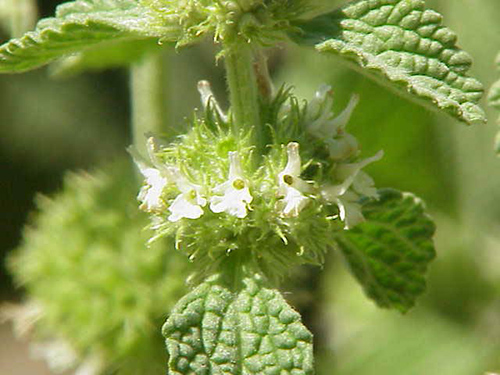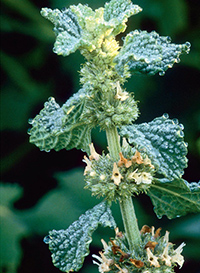Contents
The horehound plant has been used since ancient times to treat respiratory system afflictions. In the first century A.C., the great Greek physician, pharmacologist, botanist, and author Pedanius Dioscorides said that this plant “expels from the chest all thick humors.” Horehound has been highly appreciated because of its virtues from then onwards.

Healing Properties and Indications
The plant contains a bitter component, marrubine, to which it owes its expectorant, bechic (easing cough and throat irritation), febrifuge, appetizer, and digestive properties. These properties are also related to its content of saponins, mucilage, and tannins. Horehound is used in the following cases:

- Respiratory system afflictions: Its action on the respiratory system is notable. Horehound liquefies and reduces the infection of the bronchial mucous membrane secretions, easing their elimination and alleviating cough. This plant is recommended for all bronchial conditions: catarrh, laryngitis, tracheitis, bronchitis, asthma, etc.
- Appetizer: Horehound is an appetizer that also promotes digestion. It is helpful for weakened people, those who suffer from chronic bronchitis, and even tuberculosis. Even though it does not directly act on tuberculosis, the plant cleans the bronchi and tones the whole body.
Horehound is especially useful for ailments like coughing and bronchial issues. It can be taken as syrup or tea as an expectorant for bronchial catarrh. It is helpful for hoarseness, coughs, and acute or chronic bronchitis. Horehound can also treat pulmonary problems and sore throats. Children should use the herb in syrup form. It is also used for typhoid fever.
Some say it can restore the average secretion balance of various glands and organs. It is used to calm heart action and heart conditions. In addition, it can boost the immune system and treat jaundice, fevers, bloating, hay fever, asthma, and dyspepsia. When taken warm, it is a diuretic; when taken cold, it makes for a fantastic stomach tonic.
The herb’s tea or crushed leaves can be externally applied to treat temporary or persistent skin problems. The smelly, bitter leaves are used in cough syrups in Europe. The herb can stimulate digestion and, as an expectorant, break up phlegm, relieve bronchitis and coughs, soothe sore throats, and treat other upper-respiratory conditions.
Horehound is an excellent herbal treatment for stomach and gallbladder disorders, jaundice, and hepatitis. Its fresh leaves can be used as a poultice to treat cuts and wounds. It can also increase the flow of bile. In Germany, it is approved as a treatment for colds and coughs, an appetite stimulant, and a digestive aid.
Horehound Plant Scientific Facts

- Other names: Hoarhound, marrubium, white horehound.
- French: Marrube.
- Spanish: Marrubio.
- Environment: The plant is common in sunny, dry, unfarmed lands all over Europe and has been naturalized in America.
- Description: This is a vibrant plant of the Labiatae family, growing from 30 to 80 cm high. It has an upright, somewhat woody stem and tiny white flowers growing in clusters along this stem.
- Parts of the plant used medicinally: The flower clusters and the leaves.
How to use Horehound
Infusion: Steep for twenty minutes and take six ounces at a time, frequently. Tincture: Take twenty to sixty drops three times daily. Fluid Extract: Take ½ to one teaspoon three times daily. Syrup: Take ½ to one teaspoon three times daily. Powder: Take five to ten #0 capsules (30 to 60 grains) thrice daily.
DISCLAIMER: All content on this website is presented solely for educational and informational objectives. Do not rely on the information provided as a replacement for advice, diagnosis, or treatment from a qualified medical expert. If you are pregnant, nursing, or have any preexisting medical concerns, talk to your doctor before using any herbal or natural medicines.
REFERENCES
- George D. Pamplona-Roger, M.D. “Encyclopedia of Medicinal Plants.” George D. Pamplona-Roger, M.D. Encyclopedia of Medicinal Plants. Ed. Francesc X. Gelabert. Vols. 1 San Fernando de Henares: Editorial Safeliz, 2000. 316. Print. [horehound plant]
- Vance Ferrell Harold M. Cherne, M.D. The Natural Remedies Encyclopedia [Book]. – Altamont, TN: Harvestime Books, 2010. – Vol. Seventh Edition: 7: pp. 163.
- WebMD – https://www.webmd.com/vitamins/ai/ingredientmono-886/white-horehound
- RxList – https://www.rxlist.com/supplements/white_horehound.htm
- PeaceHealth – https://www.peacehealth.org/medical-topics/id/hn-2109003
- https://www.drugs.com/npc/horehound.html
